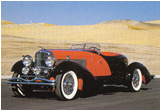
SPECIFICATION
Engine:
Straight eight; 95.25 x 120.65 mm, 6876 cc; ohv; max power, 250 bhp at 4,200 rpm
Transmission:
Three speed manual gearbox.
Suspension:
Front; non-independent, semi-elliptic springs and shock absorbers; rear; live axle semi-elliptic springs and shock absorbers.
Brakes:
Drum brakes
Dimensions:
Wheelbase: 142.5 in (362 cm);
Track: Front and Rear: 56 in (142 cm)
Max speed:
Two seater 116 mph (186 kmh)
|
Duesenberg Model J 1929/40
When he took over the Duesenberg company in 1926, Errett Loban Cord did not squander Fred Duesenberg's talents but put him to work on the design of a road car that was to couple high performance with the highest possible quality in construction and fittings. It took shape as the model J, launched at the 1928 New York Auto Show with a price tag of $8,500 before a body was added.
Massive
The chassis side members of the J were 8.5 in/21.6 mm deep, and the chassis weighed more that 4400 lb/2000 kg before coachbuilders added bodywork. the straight eight was built by aero engine company Lycoming to Duesenberg requirments, and it's 250 bhp output was not far short of publicity claims of 265 bhp. It had real road potential though, and the 5500 lb/2500kg four seater could reach 115 mph/185 kmh
Real performance
Prince Nicholas of Rumania twice ran a J at Le Mans, but the car made no impression in the 24-hour race. The supercharged SJ that came in 1932 had some 320 bhp and was 130 mph/209 kmh car. Outwardly it was distinguished by large chromed exhausts and that led some owners to add dummies to J2s! Finally there were two short wheelbase SS SJs in 1939. The Dusenberg plant was sold in 1937, but the last J (the 472nd) was completed as late as 1940.
A model J Speedster with Figoni body which does not wholly disguise the car's bulk. The lower driving lights turn with the steering.
Photo Autopresse
MCMXCI, Edito-Service S.A. D1 078 03-20
|